Reach Voters With AM/FM Radio
Click here to view a 9-minute video of the key findings.
Kantar’s Campaign Media Advisory Group (CMAG) projects a $7.8 billion political ad spend for the midterm season across local broadcast TV, local cable/satellite, AM/FM radio, digital, and OTT.
Still, $7.8 billion will overwhelm inventories of many TV and digital platforms leaving campaigns to look for new ways to reach voters. Enter AM/FM radio.
AM/FM radio has huge reach among registered voters
Among registered voters, AM/FM radio is one of the big four mass reach media.
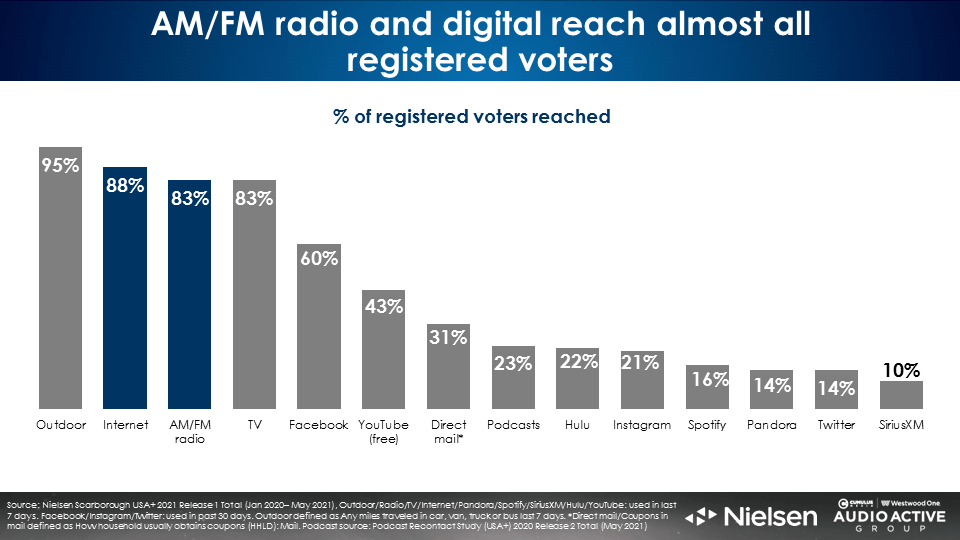
AM/FM radio adds significant incremental reach to TV buys due to voter cable cord cutting, light TV viewers, and declining TV ratings
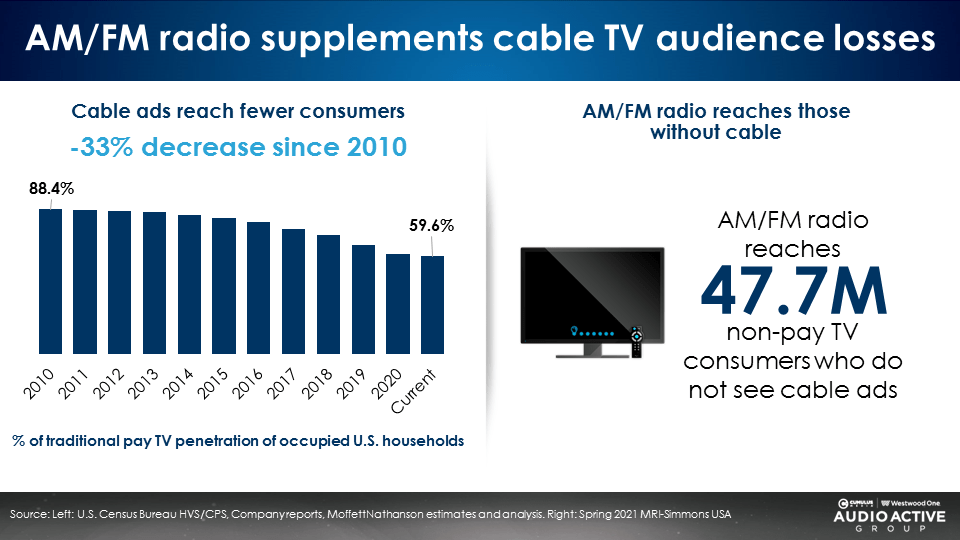
- Cable ads reach fewer voters: MoffettNathanson reports 40% of the U.S. does not subscribe to cable. With a -33% decrease in cable homes since 2010, cable ads reach fewer voters.
- AM/FM radio reaches those without cable: MRI-Simmons reports AM/FM radio reaches 47.7 million voters without cable who do not see ads on channels like CNN, Fox News, and MSNBC.
39% of voters are impossible to reach on TV
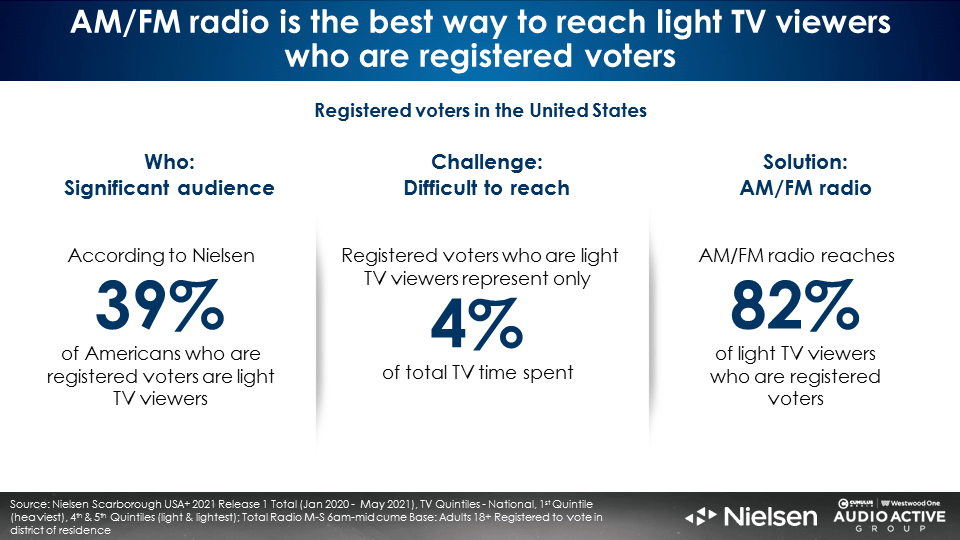
Light TV viewers: According to Nielsen, 39% of registered voters are light or no TV viewers. They generate only 4% of total TV time spent. It is nearly impossible to reach light TV viewers with TV.
The solution: Add AM/FM radio. AM/FM radio reaches 82% of registered voters who are light TV viewers.
New York Times: Political TV clutter is white noise while AM/FM radio’s lack of clutter makes it more effective
TV has an over-abundance of political ads that voters tune out like wallpaper. According to The New York Times, campaign strategists say AM/FM radio ads are “more effective at getting a candidate’s message through to its intended audience.”
Political consultant Doug Watts notes political clutter on TV is “a basket full of white noise.” Watts tells The New York Times, “People are spending millions of dollars, and every other spot is going to be a political spot. You’ve got to find a way around that.”
Nielsen reports leading up to last year’s senatorial elections in Georgia, political represented one out of three TV ads in Atlanta. Political ad volumes on TV were two to three times that of AM/FM radio. Political ads on AM/FM radio stand out more and afford an unfair share of voice.
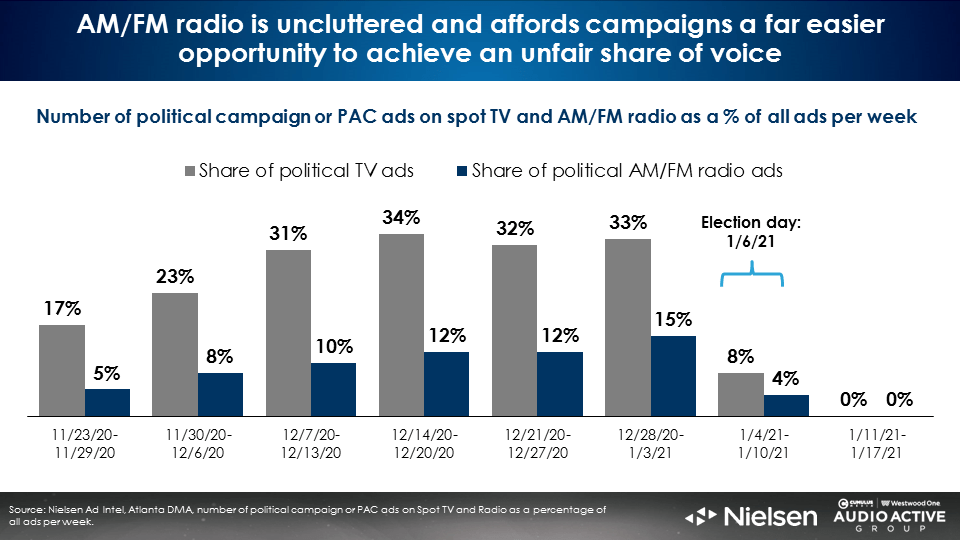
Nielsen: Moving money to digital/social does not grow voter reach when TV is sold out
If TV and YouTube are sold out, moving budgets over to digital is an option. The challenge, according to Nielsen’s media optimization platform Nielsen Media Impact, is that increasing digital allocations does not grow voter reach.
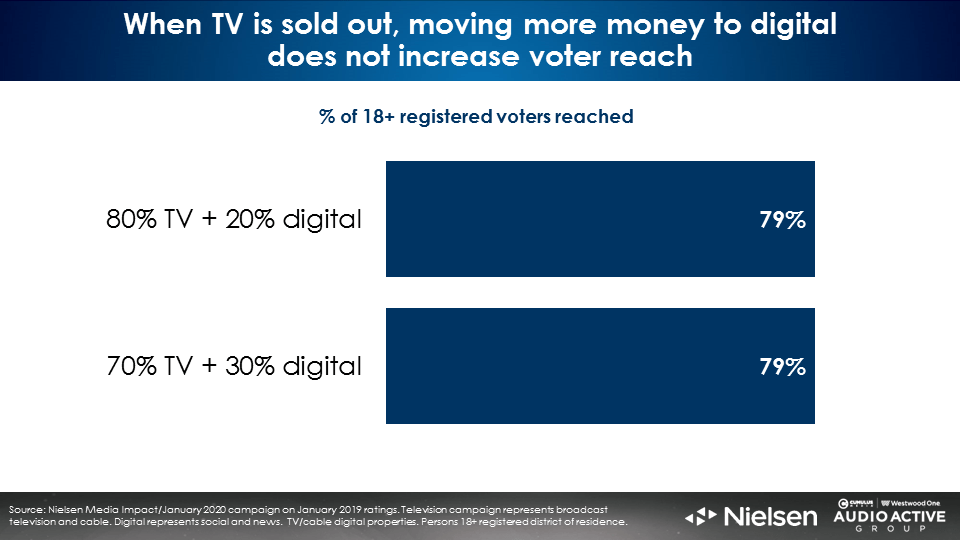
In this analysis, Nielsen found that shifting the same budget from an 80%/20% TV/digital mix to a 70%/30% TV/digital allocation does not increase voter reach. Voter reach is stuck at 79% despite increasing digital allocation from 20% to 30%. One out of five registered voters is not reached.
Adding AM/FM radio to a TV/social/digital buy generates a +15% increase in voter reach for the same budget
Keeping the overall budget flat and shifting 20% of spend to AM/FM radio generates meaningful growth in voter reach (79% to 91%), a +15% increase.
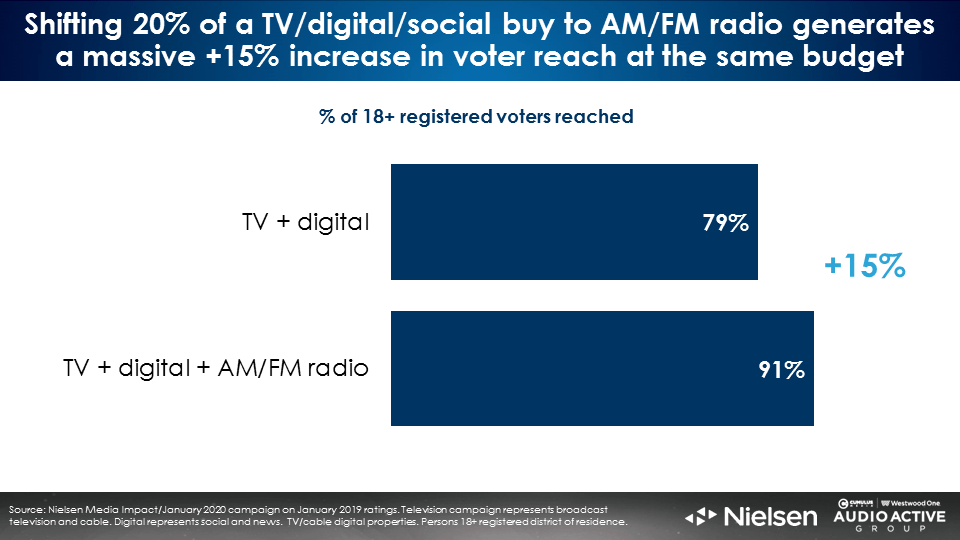
AM/FM radio has a 74% share of ad-supported audio among registered voters
According to the latest “Share of Ear” study from Edison Research, AM/FM radio dominates listening among registered voters. AM/FM radio’s share of ad-supported time spent is over six times the nearest platform. 74% of all ad-supported audio time spent goes to AM/FM radio.
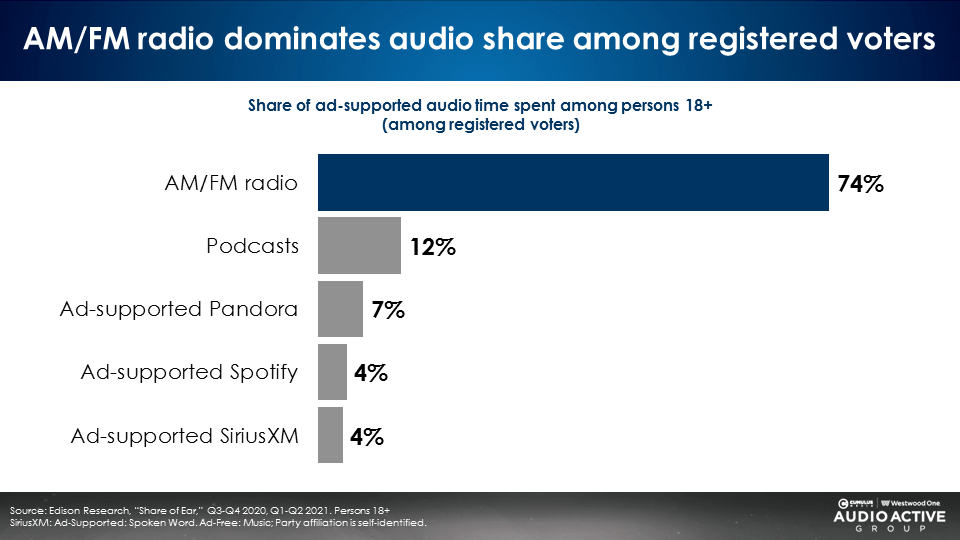
Among registered voters, AM/FM has an 87% share of in-car ad-supported audio
AM/FM radio’s 87% share of in-car ad-supported time spent among registered voters is 17 times bigger than the nearest platform.
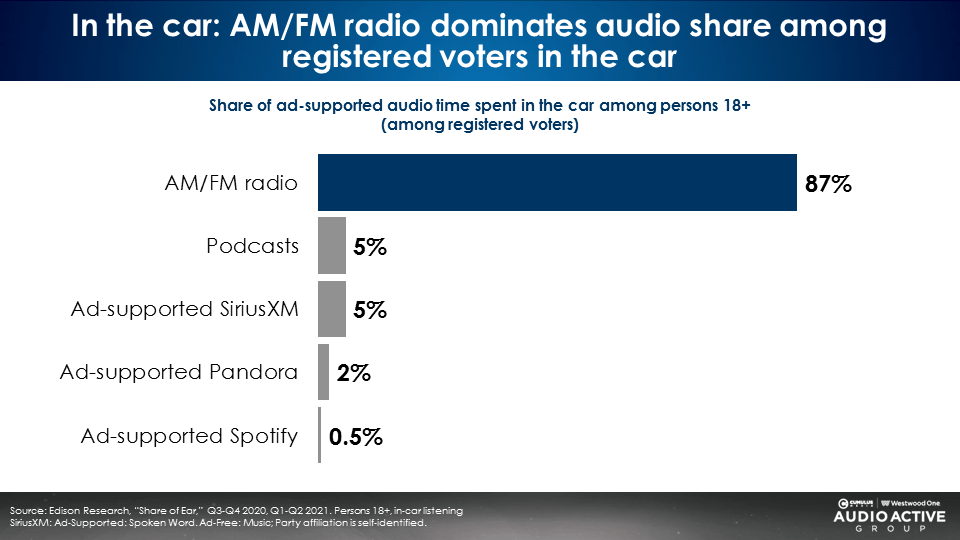
AM/FM radio reaches an engaged and captive audience in the car
One of AM/FM radio’s main benefits over other media is the ability to reach a captive audience. Consumers cannot multi-task and are a more attentive audience when driving.
Political campaigns can target swing voters with AM/FM radio
According to Nielsen Scarborough, large portions of each AM/FM radio format audience represent swing voters (moderates, independents, and unaffiliated voters). About 40% to 50% of each format falls into the swing voter segment.
Given the narrow margins of recent political contests, reaching all swing voters is crucial. Putting AM/FM radio into the political plan increases reach especially among swing voters.
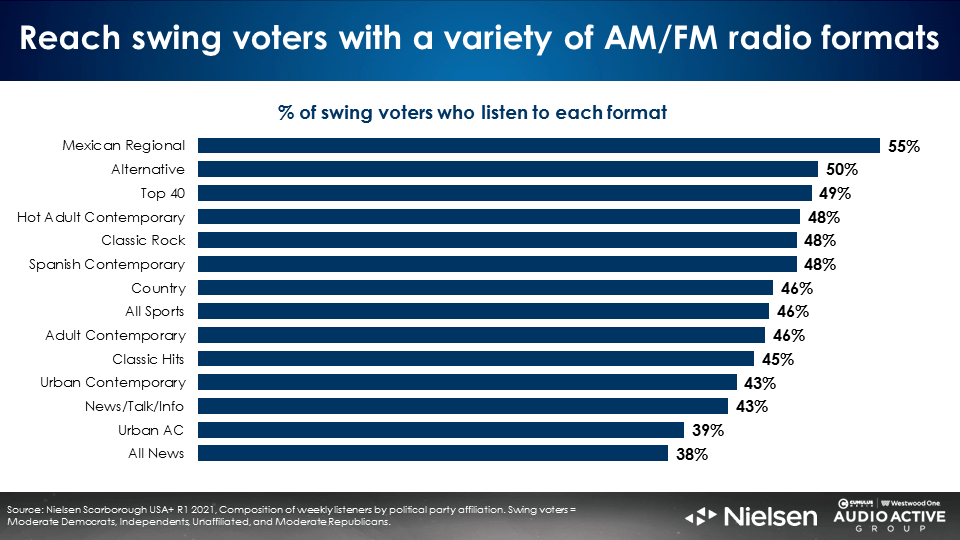
Key takeaways:
- AM/FM radio delivers mass reach with voters and should be used like TV to reach a broad audience
- AM/FM radio reaches the vast majority of voters who are impossible to reach on TV
- Adding AM/FM radio to the TV/digital plan generates significant lift in voter reach
- AM/FM radio ads stand out more and afford political ads an unfair share of voice
- Among registered voters, AM/FM radio has a dominant 74% share of ad-supported audio and a 87% share in-car
- Many AM/FM radio programming formats offer large audiences of swing voters
Click here to view a 9-minute video of the key findings.
Pierre Bouvard is Chief Insights Officer at CUMULUS MEDIA | Westwood One and President of the CUMULUS MEDIA | Westwood One Audio Active Group.
Contact the Insights team at CorpMarketing@westwoodone.com.